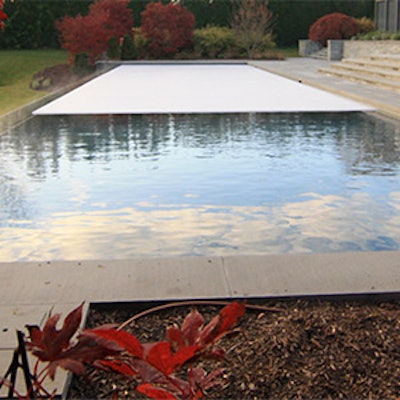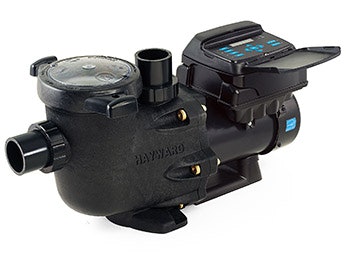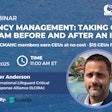
Early in 2016, as Californians braced themselves for another hot and dry summer, the clouds opened up and rain poured on the state, temporarily easing the squeezed water districts who had threatened homeowners with backyard pools. Fall brought further relief, buoying hopes that a good rainy season could even bring the historic drought to an end, at least in the north.
But for Dan Johnson, a builder and consultant in Sarasota, on Florida's water-wealthy Gulf Coast, the rain did little to wash away his worries about the future of the industry. For years he'd seen pools and spas demonized as water (and energy) hogs not just in drought-stricken California, but across the entire Southwest and anywhere else state and local officials talked of restricting water use and saw pools as a convenient place to focus attention.
Handy ResourceTo purchase the new ANSI/APSP/ICC -13 2017 Standard for Water Conservation Efficiency in Pools, Spas, Portable Spas and Swim Spas, visit APSP.org/Store. |
"California was even considering prohibiting new pool construction or renovation," Johnson says, recalling the hysteria surrounding the state's latest bout with long-term drought. "When that came to the surface — and the concept had been hanging around in the background for years prior to that — we realized if we don't do something about water efficiency in our own industry, someone else is going to do it for us. And we're not going to like what they do."
Retired service pro Paul Wahler had the same revelation, though he resides in the Metro-D.C. area, far from the desert Southwest. "I get it that you can watch the news up in Wisconsin about the California drought and think it doesn't mean a damn thing to your business," he explains. "But I have to say that water conservation is going to be a much greater issue all across the country in the next couple of decades, and not just in California, Nevada, Arizona and Texas. Everyone needs to get on board with saving water."
Call To Action
Wahler and Johnson both volunteered to serve on an APSP committee assembled to draft a standard focusing on water conservation, with Wahler bringing a boatload of service education experience with APSP and Johnson having served on the association's standards-writing committees on construction, energy and safety.
They were joined by other concerned industry professionals to write a standard for both new and existing pools and spas that would decrease water loss and increase system efficiency in the name of limiting water waste. The resulting document, ANSI/APSP/ICC -13 2017 Standard for Water Conservation Efficiency in Pools, Spas, Portable Spas and Swim Spas, has been ANSI approved.
RELATED: Drought-Proofing Tips for Pools
"The goal of the standard is to give our industry professionals a resource guideline to actually engage their pool and spa customers with tried-and-true methods on how to proactively and easily conserve this precious resource," says Carvin DiGiovanni, APSP vice president of technical and standards. "A lot of 'how to' customer water conservation tips are in the appendices of the standard."
 Hayward's TriStar Variable Speed Pump offers tremendous energy savings in a swimming pool pump.
Hayward's TriStar Variable Speed Pump offers tremendous energy savings in a swimming pool pump.
All stakeholders — industry professionals, homeowners and governmental officials — will readily see that water-saving methods are fairly simple and usually couple with cost savings.
"We worked very hard to ensure that this standard would benefit everyone," Johnson says. "It will benefit the municipalities that are suffering from drought conditions, it will benefit the consumers who will save money and not lose as much heated and chemically treated water and it will benefit the industry because it will give us another sales tool." (see sidebar, "Show And Sell.")
PR Problem
In any area where water use comes under scrutiny, pools and hot tubs present an inviting target. Wealthy homeowners, big backyards and pools awash with tens of thousands of gallons of water must be a big part of the problem, right?
"That's simply not true," says Ken Gregory, compliance and safety manager with Pentair Water Quality Systems in Sanford, N.C. He had key input into the standard, and as a member of the Florida Building Commission, brought valuable insider experience. Like Johnson, he stresses the need for the industry to regulate itself, lest someone step in and do it for us.
"I got some political advice from a good friend of mine, Tom Feeney, who's a congressman in Florida," Gregory says. "He told me, 'If you don't have a seat at the table, you're most likely going to be on the menu.'
"I wanted to deliver that message to the pool industry, because our history has been that we're so busy working in our own businesses that we really don't have time to work on our businesses — or on the larger industry. Having this standard to refer to is a great positive step for the industry in the water conservation area.
 The Jandy Pro Series JXi with VersaFlo saves energy at the heater through bypassing the heat exchanger when the heater isn't in heat mode.
The Jandy Pro Series JXi with VersaFlo saves energy at the heater through bypassing the heat exchanger when the heater isn't in heat mode.
"When California was considering legislation to deny new swimming pool permits, and to restrict draining of existing pools, well, we knew that if that went forward it would have devastated our industry."
RELATED: 3 Tips for Marketing Your Business During Drought Conditions
Gregory credits APSP and the California Swimming Pool and Spa Association with educating legislators and regulators about how little water a pool actually uses when compared with a patch of lawn the same size. The victory was significant, but likely to be fleeting, and continued vigilance will be required to keep overzealous regulators at bay.
CPSA President John Norwood, an experienced industry lobbyist, was involved in that successful effort. His association developed a statewide campaign called "Let's Pool Together," aimed at educating California's citizens and politicians about water use by pools and spas and what people could do to conserve water.
"Anything in the way of a proactive effort to educate the public, public policy makers and opinion makers that places the industry in the role of trying to be part of the solution is positive," Norwood explains. "The real win has been that we have been successful in convincing public policy makers from the governor down and the media that swimming pools, spas and swim spas are not water wasters."
APSP-13 has a similar goal, and contains similar information aimed at persuading lawmakers and pool builders that the industry's products are not a significant part of the drought problem, so long as certain rules are followed. Here again, the APSP standards speak to the industry's position and in this case, on water conservation, before the regulators. They will see that the industry is taking steps to responsibly regulate itself and as such, will take a favorable view when thinking about which industries to restrict. The trick however, is to get the standard before your local water board before a drought situation arises.
Take A Closer Look
 The IntelliFlo 2 VST pump is a smart choice when it comes to pool equipment that conserves energy and water.
The IntelliFlo 2 VST pump is a smart choice when it comes to pool equipment that conserves energy and water.
The main body of APSP-13 is broken into sections for new construction and existing pools. There's some overlap, but the drafters wanted to separate the two to avoid burdening builders or service people with regulations that didn't apply to their work.
For new pools, the standard calls for fill water to be monitored, splash-out to be minimized with deck design, evaporation to be slowed with covers, potential leaks to be monitored, pumps and filters to be sized to save water through increased times between backwashes and more.
RELATED: 3 Tips for Pool Care During Drought Season
For existing pools, the standard calls for monthly "bucket tests" to test for leaks, testing for and reducing total dissolved solids, and monitoring system pressure to avoid backwashing too frequently. Automatic water levelers (automatic refill) are carefully considered. On the one hand they eliminate the problem of dropping a hose in and forgetting about it until thousands of gallons have been dumped to sewage. On the other hand, blindly relying on them can prevent the discovery of leaks. That's where the good old-fashioned bucket test comes in.
"Pools consume more water than lawns if you've got a leak," Johnson says. "And in the APSP 13 appendix there are instructions for the evaporative bucket test. It's easy to do, and the evidence, if you do it correctly, is irrefutable."
While the bucket test and the other water-saving standards spelled out in APSP 13 aren't new, APSP's increased emphasis on them is.
"I've been in the industry for a long time, and I'm not sure a lot of pool contractors see themselves as part of a larger industry," Gregory says. "They see things from their own viewpoints in their own parts of the country.
"Even the guys in California didn't embrace these ideas until the municipalities said, 'We're not going to let you pull any permits.' Well, when they saw that this was going to put them out of business, everybody started getting involved."
Show And SellWater conservation makes for a powerful sales pitch When the world economy faltered in 2008, sales of pools, spas and portable spas mirrored losses on the Dow and S&P 500, falling sharply and breaking through what people always assumed to be rock bottom, only to plunge even deeper. Countless pool builders went belly up in the following few years, but the best struggled, survived and are still counted among the living today, nearly 10 years later. Then there are those that beat the downturn entirely. "That first year we lost a little money," Johnson says. "Not much; hundreds, not thousands. The next year we gained a little, and throughout the rest of it we kept growing. "The only reason we did is because we took advantage of the new VGB pool safety law and the ANSI/APSP-7 standard on suction entrapment avoidance to sell safety as part of our new installs. When Clean Water Design's salespeople found that selling safety was a powerful tool, and when they called on homeowners with children, they had a commanding advantage over competitors that didn't even bother to bring it up. "We always got those jobs," Johnson says. He now sees a similar opportunity to strengthen sales pitches by talking about water conservation and building that technology in accordance with the new APSP-13 standard. "We will actively try to promote it," Johnson says. "Any builder who uses the standard as a sales tool just lends that much more credibility to them as a builder. It shows customers you care about the environment, and about their expenses." Service professionals can also get in on the act and differentiate themselves from competitors who continue to play the "splash and dash" game. "I'd tell my customers I'm only going to clean their sand filters when the pressure gauge is 8-12psi higher than a clean reading, for example. That saves both water and labor," he explains. "Or I'll recommend a variable-speed pump and larger filter, showing them energy and water savings over time." Another way to get a jump on the competition is to promote, or perhaps add to your list of services a monthly bucket test for evaporation, which can uncover wasteful leaks, or to program water features to run only when people are around to see them. Why have a fountain spraying water into the wind while everyone is at work? All of these and other methods are spelled out in the APSP-13 standard and its four easy-to-read appendices. "We really want to get contractors and service people thinking about water conservation," Gregory says. "A lot of people try to build cheaper so they can sell cheaper, without thinking about what's good for the environment and the customer. We as an industry need to promote water conservation, and that's part of the momentum and trend we're trying to do with APSP-13." |
How Much Water Do Pools Really Use?Let's dispel some misconceptions about backyard water Three years ago the California Pool and Spa Association launched the "Let's Pool Together" campaign to educate the public and elected officials about water use in pools and hot tubs. It contains some of the same provisions spelled out in the appendices to the new APSP-13 standard, including an interesting comparison of water consumption of a particularly sized pool vs. the amount of water necessary to water the same size of grass to replace it. CSPA cites a study done by a water district in the Sacramento area that suggests a well-maintained pool or spa uses less water per day than an irrigated lawn. Officials north in Santa Margarita came to a similar conclusion and lifted a ban they had placed on filling new pools or adding more than a foot of water to existing pools. Here's an excerpt from CSPA's campaign, which has proven useful in persuading government officials in California to reconsider industry-strangling water bans.
|









































